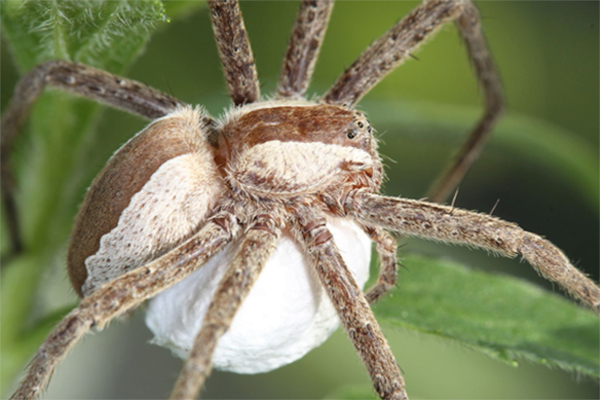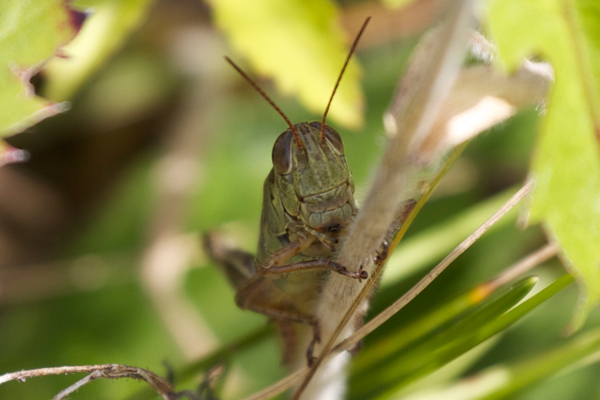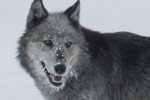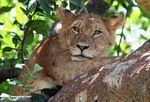What does a wolf in Yellowstone National Park have in common with an ambush spider on a meadow in Connecticut? Both are predators and thus eat herbivores, such as elk (in the case of wolves) and grasshoppers (in the case of spiders). Elk and grasshoppers also have more in common than you probably imagine: they both consume large quantities of plant matter. While scientists have long-known that predators lead to carbon storage by reducing herbivore populations, a new study reveals a novel way in which top predators cause an ecosystem to store more carbon.
The paper, published in the Proceedings of the National Academy of Sciences (PNAS) found that by forcing herbivores to be more vigilant, carnivores indirectly reduce the grazing pressure on the plants. If you are a grasshopper and there are spiders in the area, you are definitely not grazing while you are looking out for them.
Interestingly though, the plants respond too. When not under attack by grazers, they start growing faster and wasting less carbon in respiration. A field experiment on Connecticut grasslands demonstrated that in the presence of predators that scare off the herbivores, plants absorbed and stored up to 40% more carbon in their bodies.
“The results provide some new food for thought about how we might use animals to manage carbon release to the atmosphere,” explains Professor Oswald Schmitz from Yale School of Forestry and Environmental Studies and one of the authors of the paper.

The sit-and-wait hunting spider carnivore Pisaurina mira used in the field experiment. Photo by: Dror Hawlena.
Grasslands make up around 40% of Earth’s landmass so the presence of predators in such systems could have a marked influence on carbon cycling. Yet we are losing top predators at a disproportionate rate. Ecologists used to think that animals mattered little to whole ecosystem functioning, but these new results—along with a flood of research in recent years—force them to think differently about the way ecosystems are controlled.
“Predators often get a bad rap… How many people kill spiders in their home without a second thought? What we’ve found is that you need to consider the larger role these predators play in ecosystems,” says Professor Michael Strickland, the lead author of the paper.
This experiment with carnivorous spiders and grasshoppers is not unique in its findings. A recent paper in The Journal of Animal Ecology found that predatory beetles altered earthworm behavior, which also led to increased plant growth. Another study in Science last year reported that predators could influence leaf litter decomposition.
The current paradigm in ecosystem science is that the main way top predators influence the plants is by keeping the population of herbivores small so that fewer plants would be eaten. However, this field experiment demonstrated that the top predator did not change the abundance of herbivores, only their behavior. The mere presence of a carnivore resulted in greater carbon intake and storage by the plants. These are examples of what scientists call ‘trophic cascades’—when removal of a top predator has indirect effects further down the food chain.

The generalist grasshopper herbivore Melanoplus femurrubrum common in grasslands. Photo by: Dror Hawlena.
CITATION: Michael S. Strickland, Dror Hawlena, Aspen Reese, Mark A. Bradford, and Oswald. J. Schmitz. Trophic cascade alters ecosystem carbon exchange. PNAS (2013)
Related articles
Obama Administration to propose stripping protection from all gray wolves
(04/29/2013) The U.S. Fish and Wildlife Service (USFWS) is proposing to end protection for all gray wolves (Canis lupus) in the lower 48 states, save for a small population of Mexican wolves in New Mexico, reports the Los Angeles Times. The proposal comes two years after wolves were removed from the Endangered Species Act (ESA) in western states by a legislative rider on a budget bill, and soon after in the midwest. Since then hunting and trapping has killed over 1,500 wolves in these two regions.
Lions for sale: big game hunting combines with lion bone trade to threaten endangered cats
(04/18/2013) Koos Hermanus would rather not give names to the lions he breeds. So here, behind a 2.4-meter high electric fence, is 1R, a three-and-a-half-year-old male, who consumes 5kg of meat a day and weighs almost 200kg. It will only leave its enclosure once it has been “booked”‘ by a hunter, most of whom are from the United States. At that point the big cat will be set loose in the wild for the first time in its life, 96 hours before the hunt begins. It usually takes about four days to track down the prey, with the trophy hunter following its trail on foot, accompanied by big-game professionals including Hermanus. He currently has 14 lions at his property near Groot Marico, about two and a half hours by road west of Johannesburg.
Over 1,500 wolves killed in the contiguous U.S. since hunting legalized

(02/06/2013) Hunters and trappers have killed approximately 1,530 wolves over the last 18 months in the contiguous U.S., which excludes Alaska. After being protected under the Endangered Species Act (ESA) for 38 years, gray wolves (Canis lupus) were stripped of their protected states in 2011 by a legislative rider (the only animal to ever be removed in this way). Hunting and trapping first began in Montana and Idaho and has since opened in Wyoming, Minnesota, and Wisconsin.
An avalanche of decline: snow leopard populations are plummeting
(01/03/2013) The trading of big cat pelts is nothing new, but recent demand for snow leopard pelts and taxidermy mounts has added a new commodity to the illegal trade in wildlife products, according to the Environmental Investigation Agency (EIA). Traditionally, the market for large cat products has centered around tiger bones and parts for traditional Chinese medicine. Snow leopards (Uncia uncia), however, are a novel trend in the illegal wildlife trade arena and skins and taxidermy mounts are the most recent fad in luxury home décor.
Lion population falls 68 percent in 50 years

(12/04/2012) African lions, one of the most iconic species on the planet, are in rapid decline. According to a new study in Biodiversity Conservation, the African lion (Panthera leo leo) population has dropped from around 100,000 animals just fifty years ago to as few as 32,000 today. The study, which used high resolution satellite imagery to study savannah ecosystems across Africa, also found that lion habitat had plunged by 75 percent.
Illegal hunting threatens iconic animals across Africa’s great savannas, especially predators

(10/25/2012) Bushmeat hunting has become a grave concern for species in West and Central Africa, but a new report notes that lesser-known illegal hunting in Africa’s iconic savannas is also decimating some animals. Surprisingly, illegal hunting across eastern and southern Africa is hitting big predators particularly hard, such as cheetah, lion, leopard, and wild dog. Although rarely targets of hunters, these predators are running out of food due to overhunting and, in addition, often becoming victims of snares set out for other species.
